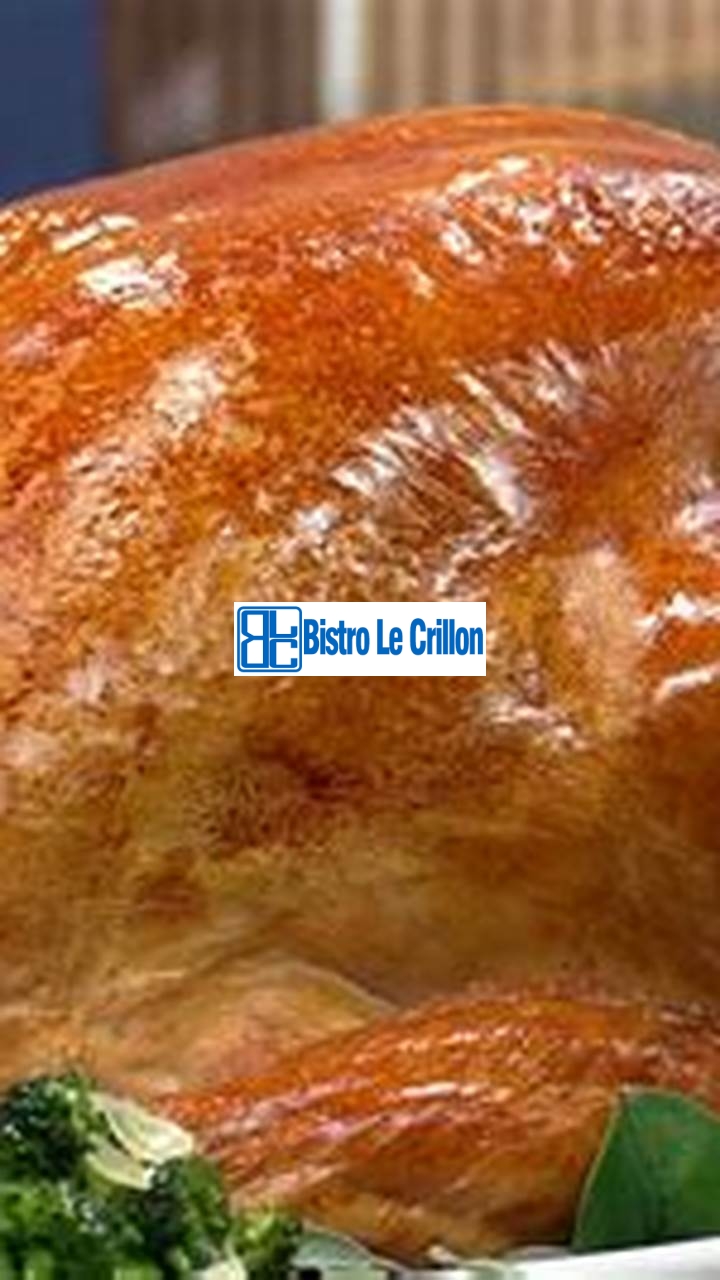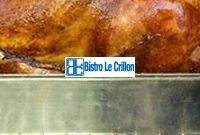Welcome to the ultimate guide on how to master the art of cooking a succulent Butterball turkey ! Whether you’re a seasoned chef or a beginner in the kitchen, this comprehensive article will equip you with all the essential tips and techniques you need to create a show-stopping centerpiece for your holiday feast. From brining to roasting and carving, we’ll walk you through every step of the process, ensuring a mouthwatering outcome that will impress your family and friends. So let’s dive in and discover the secrets to achieving a perfectly cooked Butterball turkey that will have everyone coming back for seconds!

Preparing Your Butterball Turkey
Discover the essential steps for preparing your Butterball turkey for cooking.
Selecting the Perfect Turkey
When it comes to cooking a delicious Butterball turkey, selecting the perfect one is crucial. Follow these tips to ensure you choose the right turkey:
- Size Matters: Consider the number of guests you will be serving. A general rule of thumb is to estimate 1 pound of turkey per person, so if you have 10 guests, a 10-pound turkey should be sufficient. However, if you desire leftovers, increase the size accordingly.
- Fresh or Frozen: Decide whether you want a fresh or frozen turkey. Fresh turkeys tend to have better flavor, but they can be harder to find and more expensive. Frozen turkeys are more readily available and often more budget-friendly.
- Butterball Quality: Butterball turkeys are known for their quality and tenderness. Look for the Butterball brand when selecting your turkey.
Thawing Your Turkey
Thawing your Butterball turkey properly is essential to ensure it cooks evenly. Follow these steps to thaw your turkey:
- Time Calculation: Plan ahead and calculate the time required to thaw your turkey. The general guideline is to allow 24 hours of thawing time for every 4 pounds of turkey. For example, if you have a 12-pound turkey, it will take approximately 3 days to thaw in the refrigerator.
- Refrigerator Thawing: The best and safest method to thaw your turkey is in the refrigerator. Place the wrapped turkey on a tray to catch any liquid and store it in the refrigerator. Make sure to keep the temperature between 33°F and 40°F.
- No Time for Refrigerator Thawing: If you’re short on time, you can use the cold water thawing method. Keep the turkey in its original packaging and place it in a sink or container filled with cold water. Change the water every 30 minutes to maintain a steady temperature. Thawing time using this method is approximately 30 minutes per pound.
- Never Thaw at Room Temperature: Thawing a turkey at room temperature is not recommended as it can lead to bacterial growth and foodborne illnesses.
Cleaning and Patting Dry the Turkey
Before you start cooking your Butterball turkey, it’s important to clean and pat it dry. Use the following steps to ensure a clean and dry turkey:
- Remove the Packaging: Take the turkey out of its packaging and discard any plastic wrapping or pop-up timers.
- Rinse the Turkey: Rinse the turkey under cold running water to remove any excess juices or ice. This step helps in maintaining hygiene.
- Pat Dry: Use paper towels to pat the turkey dry. Absorbing the moisture will help the skin crisp up during the cooking process.
- Sanitize Surfaces: After handling the raw turkey, make sure to sanitize any surfaces, utensils, or cutting boards that came into contact with it to prevent cross-contamination.
By following these steps, you will be well on your way to mastering the art of cooking a delicious Butterball turkey. Remember to always prioritize food safety and enjoy the rewarding experience of serving a flavorful turkey to your guests.
Seasoning and Flavoring Techniques
When it comes to cooking a Butterball turkey, seasoning and flavoring play a crucial role in enhancing its taste. There are various techniques you can use to ensure a delicious and flavorful turkey that will impress your guests. In this article, we will explore three popular seasoning and flavoring methods: traditional seasoning options, herb butter rub, and brining. Let’s dive in and discover how to master the art of cooking a Butterball turkey!
Traditional Seasoning Options
Traditional seasoning options are a classic choice for adding flavor to your Butterball turkey. These options include salt, pepper, garlic powder, onion powder, and paprika. To create a mouthwatering taste, sprinkle these seasonings generously over the turkey’s surface, ensuring full coverage. Additionally, you can stuff the turkey with aromatic ingredients, such as onions, celery, and herbs like rosemary and thyme.
- ️ Tip: For an extra burst of flavor, massage the seasonings onto the turkey’s skin and let it marinate in the refrigerator for a few hours before cooking.
Herb Butter Rub
If you want to take your Butterball turkey to the next level, try using a herb butter rub. This technique involves mixing softened butter with herbs like thyme, rosemary, and sage, along with minced garlic. The herb butter rub not only adds incredible flavor but also helps keep the turkey moist during cooking. Before roasting the turkey, carefully separate the skin from the breast and gently rub the herb butter mixture onto the meat.
- ️ Tip: Make sure to apply the herb butter rub evenly to ensure that every bite of the turkey is infused with delicious herb flavors.
Brining for Flavorful Results
Brining is an excellent technique to achieve a flavorful and juicy Butterball turkey. Brining involves soaking the turkey in a mixture of water, salt, sugar, and additional flavorings. The process allows the turkey to absorb the brine, resulting in a moist and well-seasoned bird. You can customize the brine by adding spices like bay leaves, black peppercorns, and citrus zest.
Before brining, make sure to thaw the turkey completely and choose a container large enough to hold the turkey and the brine. Place the turkey in the brine mixture and refrigerate for the recommended time, allowing the flavors to seep into the meat.
- ️ Tip: Rinse the turkey thoroughly after brining to remove excess salt and pat it dry before cooking to achieve a crispy skin.
By utilizing these seasoning and flavoring techniques, you can elevate the taste of your Butterball turkey and create a memorable dining experience. Whether you opt for traditional seasonings, a herb butter rub, or the brining method, each technique will add its unique touch to the succulent bird. So get ready to impress your family and friends with your culinary skills and enjoy a Thanksgiving feast like no other!
Cooking Methods for Butterball Turkey
In order to master the art of cooking a Butterball turkey, it is essential to explore and understand different cooking methods. Each method presents a unique way to prepare and cook your turkey to perfection. Whether you prefer the traditional roasted turkey, the flavorful deep-fried turkey, or the smoky and charred notes of a grilled turkey, there are options to suit every taste. Let’s dive into the details of each cooking method and discover the secrets to cooking a mouthwatering Butterball turkey.
Roasting the Turkey
Roasting a Butterball turkey remains the most customary and classic method of cooking this holiday centerpiece. To achieve a succulent and evenly cooked bird, follow these steps:
- Preheat your oven to 325°F (165°C) and ensure the turkey is thawed completely.
- Place the turkey on a roasting rack in a shallow roasting pan, breast-side up.
- Season the turkey with your desired spices and herbs. You can create a flavorful rub using salt, pepper, garlic powder, and a touch of paprika.
- Baste the turkey with melted butter to enhance its juiciness.
- Insert a meat thermometer into the thickest part of the turkey’s thigh, avoiding the bone.
- Roast the turkey until the internal temperature reaches 165°F (74°C) for both the breast and the thigh.
Roasting your Butterball turkey allows the flavors to develop and the skin to turn a beautiful golden brown while retaining its juicy tenderness.
Deep Frying the Turkey
For those who crave a crispy and flavorful Butterball turkey, deep frying is an excellent cooking method. Here’s how you can safely deep fry your turkey:
- Ensure you have a deep fryer specifically designed for turkeys. Place the fryer outdoors, away from buildings and flammable materials.
- Thaw your turkey completely and pat it dry before frying.
- Fill the fryer with the appropriate amount of oil, as indicated by the manufacturer’s instructions. Peanut or vegetable oil are popular choices.
- Preheat the oil to 350°F (177°C).
- Carefully lower the turkey into the hot oil, using the turkey holder or a hook for safety.
- Fry the turkey for approximately 3 to 4 minutes per pound, ensuring the internal temperature reaches 165°F (74°C) in the thickest part of the thigh.
- Remove the turkey from the oil and let it rest for at least 20 minutes before carving.
♨️ Deep frying a Butterball turkey results in a deliciously crispy skin and succulent meat that is sure to impress your guests.
Grilling the Turkey
For an alternative and smoky twist to your Butterball turkey, grilling is a fantastic option. Follow these steps to achieve a delectably grilled turkey:
- Prepare your grill for indirect heat cooking. If you’re using charcoal, arrange the briquettes on one side of the grill. If you’re using a gas grill, preheat one side to medium-high and leave the other side off.
- Season your turkey with your preferred herbs and spices.
- If using a charcoal grill, add soaked wood chips to create a flavorful smoke.
- Place the turkey on the side of the grill without direct heat, positioning it over a drip pan to collect any drippings.
- Cover the grill and cook the turkey with the grill lid closed, maintaining a temperature of around 325°F (165°C).
- Cook the turkey until it reaches an internal temperature of 165°F (74°C) in the thickest part of the thigh.
- Allow the turkey to rest for 20 minutes before carving.
Grilling a Butterball turkey imparts a smoky flavor, while the grill’s heat locks in the juices for a flavorful and moist bird.
By mastering these cooking methods, you can elevate your Butterball turkey to new levels of deliciousness. Whether you choose to roast it, deep fry it, or grill it, your turkey will surely be the star of your next feast!
Monitoring the Cooking Process
Understanding the importance of monitoring and checking the internal temperature of your Butterball turkey throughout the cooking process is crucial for achieving a perfectly cooked bird. Keeping a close eye on your turkey ensures that it reaches the ideal temperature for both safety and taste. In this section, we will explore two key aspects of monitoring the cooking process: using a meat thermometer and perfectly timing the cooking.
Using a Meat Thermometer
One of the most effective ways to monitor the internal temperature of your Butterball turkey is by using a meat thermometer. This handy tool not only provides accurate readings but also ensures that your turkey is cooked to perfection. To use a meat thermometer, follow these simple steps:
- Insert the meat thermometer into the thickest part of the turkey’s thigh, avoiding contact with the bone. This will give you the most accurate reading.
- Wait for the temperature to stabilize. The thermometer should display the internal temperature of the turkey.
- Ensure that the turkey has reached the minimum safe internal temperature of 165°F (74°C) to avoid any risk of foodborne illnesses.
By using a meat thermometer, you can be confident that your Butterball turkey is cooked through and safe to eat. Remember to clean your thermometer thoroughly after each use to prevent cross-contamination.
Perfectly Timing the Cooking
Timing is everything when it comes to cooking a Butterball turkey to perfection. To achieve a moist and flavorful turkey, it is essential to follow the recommended cooking times based on the weight of your bird. Here are some general guidelines to help you with timing:
- For a fully thawed turkey:
- Cook it at 325°F (163°C) for 12 minutes per pound.
- For example, if your turkey weighs 15 pounds, the total cooking time would be 180 minutes or 3 hours.
- For a partially thawed turkey or a turkey from the refrigerator:
- Increase the cooking time slightly to compensate for the turkey’s lower initial temperature.
- Use a meat thermometer to ensure it reaches the minimum safe internal temperature of 165°F (74°C).
Keep in mind that these are just general guidelines, and it’s important to follow the specific instructions provided by Butterball for your turkey size. Adjustments may be necessary based on your individual oven and cooking conditions.
Checking for Doneness
Checking for doneness is the final step in mastering the art of cooking a Butterball turkey. To determine if your turkey is fully cooked and ready to be enjoyed, follow these helpful tips:
- Check the internal temperature: Ensure that the thickest part of the turkey reaches a minimum internal temperature of 165°F (74°C). This guarantees that any harmful bacteria are destroyed.
- Inspect the juices: Pierce the turkey’s thigh with a fork. If the juices run clear without any traces of pink, it is a good indication that the turkey is cooked through.
- Look for golden brown skin: A well-cooked Butterball turkey should have a beautifully golden brown skin. This is a visual cue that the turkey is cooked to perfection.
Once you have confirmed that your Butterball turkey meets all these criteria, it’s time to let it rest for about 20 to 30 minutes before carving. This allows the juices to redistribute, resulting in a more tender and flavorful turkey.
Remember that these guidelines are specifically for cooking a Butterball turkey. Different turkey brands or sizes may require adjustments to the cooking process. Always refer to the instructions provided with your specific turkey for the best results.
By monitoring the cooking process, using a meat thermometer, perfectly timing the cooking, and checking for doneness, you can master the art of cooking a Butterball turkey and impress your family and friends with a delicious holiday feast.
Serving and Carving Your Butterball Turkey
When it comes to serving and carving your perfectly cooked Butterball turkey, there are a few tips and techniques that can help you present a beautiful and delicious centerpiece for your Thanksgiving feast. Whether you’re a seasoned chef or a novice cook, mastering the art of serving and carving your turkey will impress your guests and elevate your holiday gathering to a whole new level.
Presenting Your Turkey
The presentation of your Butterball turkey is essential to create a visually appealing and appetizing centerpiece. Here are some tips to help you present your turkey with style:
- Place your cooked turkey on a large platter or cutting board. This will make it easier to carve and serve.
- Garnish the platter with fresh herbs, such as rosemary and thyme, to add a pop of color and fragrance.
- Consider using a decorative turkey-shaped platter for a festive touch.
- Arrange the turkey slices neatly on the platter, making sure to display the golden skin.
Remember, presentation is key when it comes to impressing your guests and making your Butterball turkey the star of the show. With these simple tips, you’ll have a stunning centerpiece that will rival any professional chef’s presentation.
Carving the Turkey
Carving the turkey can be a daunting task if you’re not familiar with the proper technique. Follow these steps for a successful carving process:
- Start by removing the legs and wings. Hold the leg with one hand and cut through the skin between the leg and the breast. Once the skin is cut, use a carving knife to separate the leg from the body. Repeat this process for the other leg and the wings.
- Next, slice the breast meat. Make a horizontal cut near the base of the breast to create a guide. Then, make vertical slices parallel to the breastbone, working your way towards the guide cut.
- If you prefer, you can also remove the entire breast from the turkey and slice it separately. To do this, make a deep cut along one side of the breastbone, following the contour of the bone. Use gentle, steady strokes to remove the entire breast in one piece. Then, slice the breast into even pieces.
- Finally, carve the dark meat. Separate the thigh from the drumstick by cutting through the joint. Slice the thigh meat and drumstick meat into individual pieces.
By following these carving techniques, you’ll ensure that each slice of your Butterball turkey is juicy and tender, making it a delight to savor.
Serving and Accompaniments
Once your Butterball turkey is carved, it’s time to serve it to your eager guests. Here are some ideas for serving and accompaniments:
️ Serve the slices of turkey on individual plates or a large platter for a buffet-style presentation.
Offer a variety of sauces and condiments, such as cranberry sauce, gravy, and a selection of mustards.
Pair your turkey with a selection of side dishes, such as mashed potatoes, roasted vegetables, and stuffing.
Don’t forget to have some freshly baked dinner rolls or warm bread on the table.
Consider serving a complementary wine to enhance the flavors of the turkey and side dishes.
With these serving and accompaniment ideas, you can create a memorable and mouthwatering Thanksgiving meal that will leave your guests impressed and satisfied.
Now that you have mastered the art of serving and carving your Butterball turkey, you can confidently showcase your culinary skills and create a holiday feast that will be remembered for years to come. Enjoy the process, have fun with your presentation, and savor each delicious bite!
Thank you for reading our article on how to cook a Butterball turkey. We hope you found the information helpful and that it inspires you to try your hand at cooking this delicious bird. Whether you’re a seasoned chef or a novice in the kitchen, cooking a Butterball turkey is a rewarding experience that is sure to impress your family and friends. We encourage you to bookmark our site and visit again later for more culinary tips, recipes, and techniques. Happy cooking!
Frequently Asked Questions
Here are some frequently asked questions about cooking a Butterball turkey:
| No. | Questions | Answers |
|---|---|---|
| 1 | How long should I cook a Butterball turkey? | The cooking time for a Butterball turkey depends on its size. A general rule of thumb is to cook the turkey for 15 minutes per pound at a temperature of 325°F. Be sure to use a meat thermometer to ensure that the internal temperature reaches 165°F for a perfectly cooked turkey. |
| 2 | Should I stuff the turkey? | It is recommended to cook stuffing separately from the turkey to ensure that both the turkey and the stuffing reach the appropriate internal temperature for safe consumption. However, if you choose to stuff the turkey, make sure to mix the ingredients just before stuffing and use a food thermometer to ensure that the stuffing reaches a minimum internal temperature of 165°F. |
| 3 | How can I make the turkey skin crispy? | To achieve a crispy turkey skin, start by patting the turkey dry with paper towels before cooking. You can also rub the skin with butter or oil and season it with herbs and spices. Additionally, you can try cooking the turkey at a higher temperature for the first 30 minutes and then reduce the temperature for the remaining cooking time. |
| 4 | How should I carve the turkey? | To carve a Butterball turkey, start by removing the legs and thighs, followed by the wings. Then, make a horizontal cut near the base of the turkey to separate the breast from the carcass. Finally, slice the breast meat against the grain into thin slices. It’s best to use a sharp carving knife and have a carving fork or tongs handy to hold the turkey steady. |
| 5 | How should I store leftover turkey? | To store leftover Butterball turkey, allow it to cool completely before placing it in an airtight container or wrapping it tightly with aluminum foil or plastic wrap. Refrigerate the turkey within two hours of cooking and consume it within three to four days. If you don’t plan to eat the leftovers within that time, you can also freeze them for up to three months. |
| 6 | Can I use the leftover turkey to make soup? | Yes, leftover Butterball turkey can be used to make delicious turkey soup. Simply chop the leftover turkey into bite-sized pieces and use it as a base for your homemade soup. Add vegetables, broth, and seasonings of your choice and simmer until the flavors meld together. It’s a great way to make the most out of your Thanksgiving feast. |
Cooking a Perfect Butterball Turkey
Now that you have all the tips and tricks on how to cook a Butterball turkey, you’re ready to create a culinary masterpiece. Remember to follow the guidelines for cooking time and temperature, and use a meat thermometer to ensure that your turkey is cooked to perfection. Don’t be afraid to get creative with seasonings and flavorings to make it your own. Whether it’s for Thanksgiving, Christmas, or any special occasion, a Butterball turkey is sure to be a hit at your table. Enjoy the process and savor the delicious results. Happy cooking!

Butterball Turkey Recipe
Ingredients
- 1 Butterball turkey 10-12 pounds
- Salt and pepper
- 2 tablespoons butter softened
- 1 teaspoon dried herbs rosemary, thyme, or sage
Instructions
- Preheat the oven to 325°F (165°C).
- Remove the neck and giblets from the turkey cavity. Rinse the turkey with cold water and pat it dry with paper towels. Season the turkey inside and out with salt and pepper.
- Combine the softened butter with dried herbs of your choice. Rub the mixture all over the turkey, including under the skin.
- Using kitchen twine, tie the turkey legs together. Tuck the wings under the turkey to prevent them from burning.
- Place the turkey on a rack in a roasting pan. Insert a meat thermometer into the thickest part of the turkey thigh, without touching the bone. Roast the turkey in the preheated oven for about 15 minutes per pound, or until the thermometer reads 165°F (74°C).
- Remove the turkey from the oven and tent it with aluminum foil. Let it rest for 15-20 minutes before carving. Carve the turkey and serve hot.






